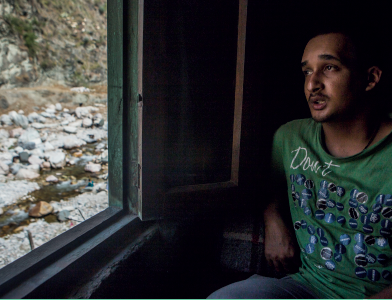Flood risk and Early Warning Systems in the Indian Himalayan Region

Introduction
Floods are one of the most frequent natural disasters which result in major loss of life, livelihoods and infrastructure in the Himalayan Region. Floods due to cloudbursts or triggered by monsoon rains have a major impact on the economy of the region. Due to developmental pressures, changing land use pattern and climate change, flooding events are likely to increase in future.
Most of the inhabited valleys in the Indian Himalayan Region (IHR) have high risk of floods. Suitable adaptation measures and related policies based on robust scientific assessments are required to respond to the increasing risk of floods in the region. However, one of the biggest challenges is lack of high-quality data on past floods. This prevents the development of long-term, high-quality predictions of future flood trends.
This science brief presents findings of a research on regional flood risk assessments and adaptation planning done for Kullu district, Himachal Pradesh, India. It provides an example of an integrated adaptation response involving long term monitoring and an Early Warning System (EWS). This document has been developed on the basis of experiences gained from a pilot study conducted for Kullu district under the Indian Himalayas Climate Adaptation Programme (IHCAP), a project of the Swiss Agency for Development and Cooperation (SDC).
Authors: Juan Antonio Ballesteros Canovas, Divya Mohan, Markus Stoffel, Mustafa Ali Khan, Janine Kuriger, Shirish Sinha
Read More about IHCAP here: https://www.weadapt.org/knowledge-base/sdc-climate-change-environment-network/indian-himalayas-climate-adaptation-programme
Results
Key findings
- Kullu district has been facing repeated floods (66 floods since 1965) with an average frequency of 1.1 events per year. This analysis was done on the basis of existing flow discharge records and data reconstructed using tree rings. The reconstructed data revealed that about 60 percent of events were not previously observed in the flow records, and therefore indicate the add value of the gathered flood reconstruction.
- The flood assessment for Kullu indicates variation in hazard levels for different catchments located in the district suggesting the need for local-level assessments in order to identify adaptation measures.
- The analysis done using reconstructed data further revealed that about 70% of the 1958 existing infrastructure in Kullu district considered in this study is categorized at very high or high flood risk. This kind of information can be useful for planning and prioritizing adaptation interventions.
Example of an Adaptation response
Based on the analysis done for Kullu district, Parvati valley has been identified as a major risk hotspot for monsoon floods, cloudburst events and potential Glacial Lake Outburst Floods (GLOFs). An adaptation response in this case can be the development of an integrated monitoring and Early Warning System (EWS) to deal with flood risk. The integrated system would include implementation of the state-of-the-art catchment-scale long-term monitoring system to assess hydro-meteorological conditions in Parvati valley, and the implementation of modern EWS with the goal to protect the identified “risk hotspots” along the valley.
The long-term monitoring of hydro-meteorological conditions would facilitate early detection of relatively slowly evolving as well as rapid onset flood threats and warning of the subsequent risk to downstream areas. It would also help in providing agro-meteorological advisories in the short term. The EWS would comprise of different components aimed at warning the population in the most critical risk hotspot areas in Parvati valley. The approach would include establishing monitoring system (flow and rain gauge stations); a data management centre; and warning systems along with raising awareness.
Recommendations
- Enhanced Preparedness:In contexts such as Kullu with high frequency of floods and large number of elements-at-risk, the most urgent adaptation action involves preparedness of the government agencies to alert and rescue local people. This action should be planned and implemented at all organizational and societal levels. For instance, in Kullu, this can be linked to the existing Himachal Pradesh Disaster Management Authority (HP-DMA). Timely information with last mile connectivity for the communities will be crucial to mitigate impacts and to limit causalities.Long-term monitoring and EWS could be developed for the most vulnerable valleys. In addition, capacity building and specialized training of communities on appropriate response mechanisms, including the identification of shelters and evacuation paths, should be developed at the local level.
- Robust database:A major risk in operating an EWS involves the possibility of false alarms (often induced by rather limited knowledge of antecedent environmental conditions and flood behaviour in general). Historical records and flood reconstructions need to be improved and applied to other regions/sectors in the area (and beyond) for a dynamic learning process and an improved understanding of how floods act in the wider IHR.
- Spatial risk and hazard mapping: A flood hazard zonation is desirable to reduce the number of elements-at-risk in regions facing flood riskssuch as in Kullu district. This will limit the use of flood plains for construction, and through the implementation of specific measures, will control flood-related problems such as network disruption, erosion and landslide and potential pollution sources.
- Flood resilient construction:Based on knowledge of flood risk, appropriate design parameters can be adopted while constructing houses and infrastructure especially in areas exposed to flood hazards. Building guidelines and their enforcement can help in facilitating such construction.
- Knowledge dissemination: The dissemination of information and training related to hazard zones, elements-at-risk and best practices will empower authorities and local citizens. Informed people will have a different risk perception.
Suggested Citation
Ballesteros Canovas, J. A., Mohan, D., Stoffel, M., Ali Khan, M., Kuriger, J. and Sinha, S. (2017) Science Brief: Flood Risk and Early Warning Systems. Indian Himalayas Climate Adaptation Programme (IHCAP): India. Available online at: http://www.ihcap.in/resources.html
Related resources
- Read about the Indian Himalayas Climate Adaptation Programme
- Read about Assessing climate vulnerability and risk in the Indian Himalayan region
- Read 'Mountain and lowland linkages: A Climate Change perspective in the Himalayas'
- Read 'Ecosystem based Adaptation: An integrated response to climate change in the Indian Himalayan Region'
(0) Comments
There is no content